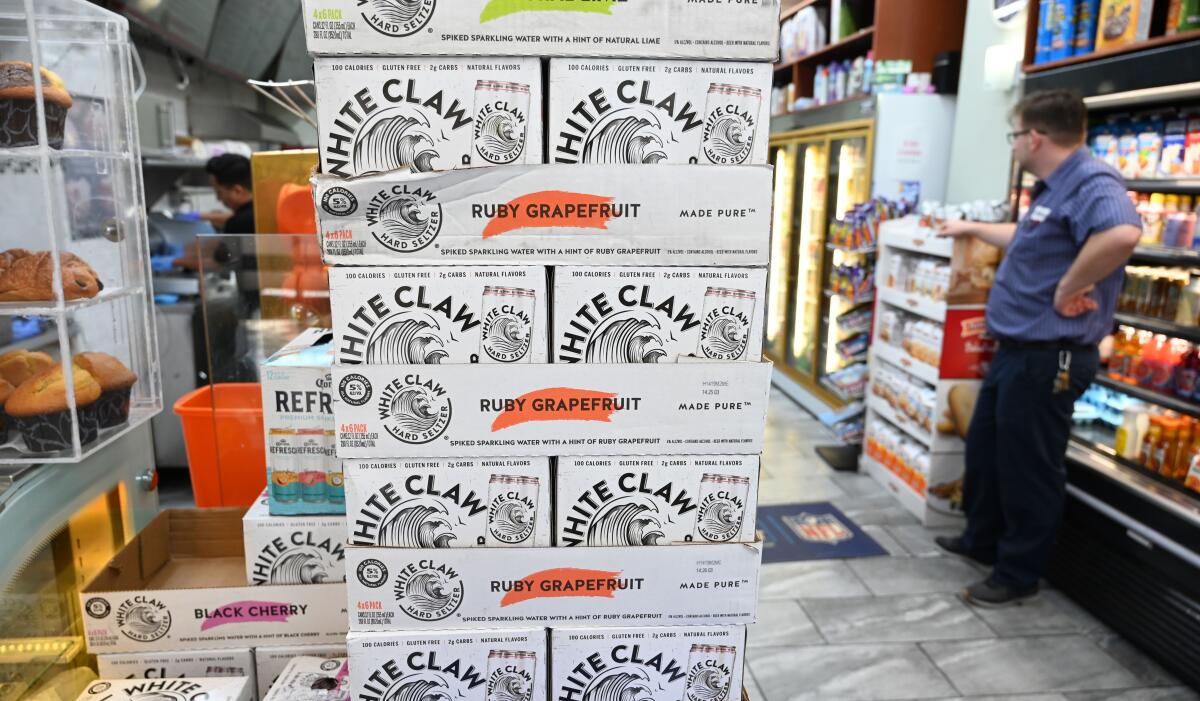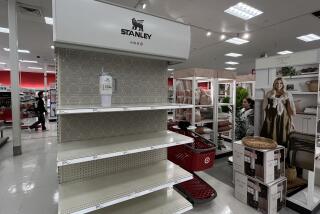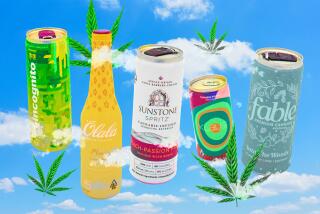Now that White Claw summer is over, will hard seltzer’s popularity go splat?

- Share via
It’s been 32 years since the popularity of wine coolers peaked. Zima’s day in the sun was a quarter of a century ago. The website that popularized “icing” — a drinking game that involved getting down on one knee and chugging a bottle of Smirnoff Ice — doesn’t even exist anymore.
Now the question is whether White Claw, the current smash in carbonated alcoholic drinks, will replicate the path of those shooting stars or maintain its surge.
White Claw is the top-selling brand of alcohol-laced “hard seltzers” that have soared in popularity the last two years to become a $1-billion segment of the U.S. beverage industry.
The multiflavored, canned White Claw drinks are riding a wave of success that’s included a rash of memes, Instagram photos, YouTube videos, outrageous drinking contests, T-shirts and Halloween costumes.
Owned by privately held Mark Anthony Group in Canada, which also makes Mike’s Hard Lemonade, White Claw debuted in 2016 and commands 60% of the booming hard seltzer market. Stores sometimes run out of the drink — becoming “declawed,” as fans say — and the firm plans to expand production to keep up with demand.
The brand in distant second place is Truly, made by Boston Beer Co., which also brews Samuel Adams beer. Then come several others, including Bon & Viv and Natural Light, or Natty, both made by brewing giant Anheuser-Busch InBev.
They’re all betting that hard seltzers can maintain their rapid growth and not fade away like other popular fizzy drinks before them.
The arc of a fad is “often referred to as the boom-splat syndrome, where a new product makes a big splash and then kind of disappears or recedes,” said Benj Steinman, publisher of the trade journal Beer Marketer’s Insights.
“I wondered if hard seltzers would be like that, but now we’re up to year four and they’re still growing at an extremely rapid pace,” Steinman said. “This is much bigger than Zima, bigger even than Smirnoff Ice, much bigger than Mike’s Hard Lemonade. It’s just a bigger wave so far.”
Perhaps the strongest signal that White Claw won’t be a quick fad is that two of the world’s biggest brewers plan to roll out new hard seltzers to catch up. And for good reason: Much of the seltzers’ success is coming at the expense of light beers, White Claw and analysts said.
Anheuser-Busch InBev plans to introduce a Bud Light seltzer as its third seltzer entry, though it hasn’t specified a launch date. Constellation Brands, brewer of Corona beer, plans a Corona Hard Seltzer next spring. Both brewers declined to elaborate on their plans or the hard-seltzer market.
Boston Beer will probably pour effort into building Truly into a more formidable competitor as well, analyst Laurent Grandet of Guggenheim Securities said in a note to clients last month: “Truly now is Boston Beer’s single largest product, accounting for more than one-third of retail sales.”
All those brewers chasing White Claw “might be taking some risk on what eventually amounts to a fad,” said Duane Stanford, executive editor of the trade journal Beverage Digest. “But they have to play in the market now because you cannot be left behind if this thing has staying power.”
U.S. retail sales of hard seltzers nearly tripled to $1.1 billion in the year that ended Sept. 7, giving the seltzers 2.8% of the total market for beer, flavored malt beverages and ciders, according to Nielsen. And that was after sales soared 165% the prior year.
White Claw alone has seen sales so far this year nearly quadruple to $638 million at the retail level, said Sanjiv Gajiwala, White Claw’s senior vice president of marketing, citing figures from the research firm Information Resources Inc.
“In Southern California, our sales have been up close to 1,000% versus last year,” Gajiwala said, declining to specify the dollar value of sales in the region. “We’re incredibly grateful for how much consumers have embraced the brand.”
White Claw is a mix of seltzer water, 5% alcohol and flavoring such as black cherry, grapefruit, lime and mango. A 12-pack of its 12-ounce cans sells for $14.99 at Target. It comes in aluminum cans with pop tops, easy to drink at parties, on the beach or anywhere else.
Hard seltzers have traits that are appealing to increasingly health-conscious consumers: The drinks are gluten free and low in sugar, calories and carbohydrates. Buyers “want alcohol, but they want low calories and a clean profile without a lot of excess ingredients,” Stanford said.
The same trends have propelled sales of non-alcoholic seltzers and sparkling waters. SodaStream, an at-home gadget that can carbonate tap water, exploded in popularity early this decade. Seltzer brands such as LaCroix and Spindrift also have benefited from consumers’ shift away from sugary sodas in recent years.
Another White Claw asset is that the brand is packaged for wide appeal, unlike, say, Zima, which was seen as mainly aimed at women.
“We didn’t pigeonhole this as a drink for women or a drink for guys. We said this is something everyone can enjoy,” Gajiwala said. “That messaging in today’s consumer culture is resonating more strongly.”
White Claw particularly captured the attention of the under-30 set, which has propelled it into a sensation on social media and elsewhere.
Comedian Trevor Wallace posted a sometimes foulmouthed video on YouTube in June, “Drinks White Claw Once,” that has been viewed nearly 3 million times. It includes a now widely used line: “Ain’t no laws when you’re drinking Claws.”
The drink was deemed a “rising star” among fans of the Coachella music festival this spring, and some media stories dubbed this summer “White Claw summer.”
Now that summer is over, there is speculation that sales of White Claw and other hard seltzers could slow in the colder months. It’s a fear the company shrugs off.
“We really feel that trend is going to continue as we head into the fall and winter,” Gajiwala said. “About 55% of White Claw volume is coming from light beers, and those light-beer occasions exist year-round.”
Sarah Montgomery, a 21-year-old junior at USC, can attest to that. She’s a White Claw fan and recently bought a multi-pack of the drink for a tailgate party before one of her school’s football games.
“It’s become a big thing to be drinking a White Claw,” she said, adding that her friends include “some very dedicated people who have wall tapestries that have the White Claw logo.”
Beyond its coolness factor, “it’s fruity, it’s light and it’s easy,” Montgomery said. “It’s easy to ask for a carton of White Claw rather than asking for a bottle of wine, because then it becomes what kind of wine? What brand? White Claw is really easy. And I think seltzers taste better than beer.”
White Claw is counting on that popularity as it prepares to spend $250 million to expand production and alleviate shortages of the drink.
“We are working around the clock to increase current supply and total capacity heading into 2020,” White Claw President Phil Rosse said in a statement, “so that we can get every consumer White Claw when they want it.”
Only time will tell how long they’ll still want it, or whether White Claw — social media, memes and all — is destined to go splat as well.
More to Read
Inside the business of entertainment
The Wide Shot brings you news, analysis and insights on everything from streaming wars to production — and what it all means for the future.
You may occasionally receive promotional content from the Los Angeles Times.











